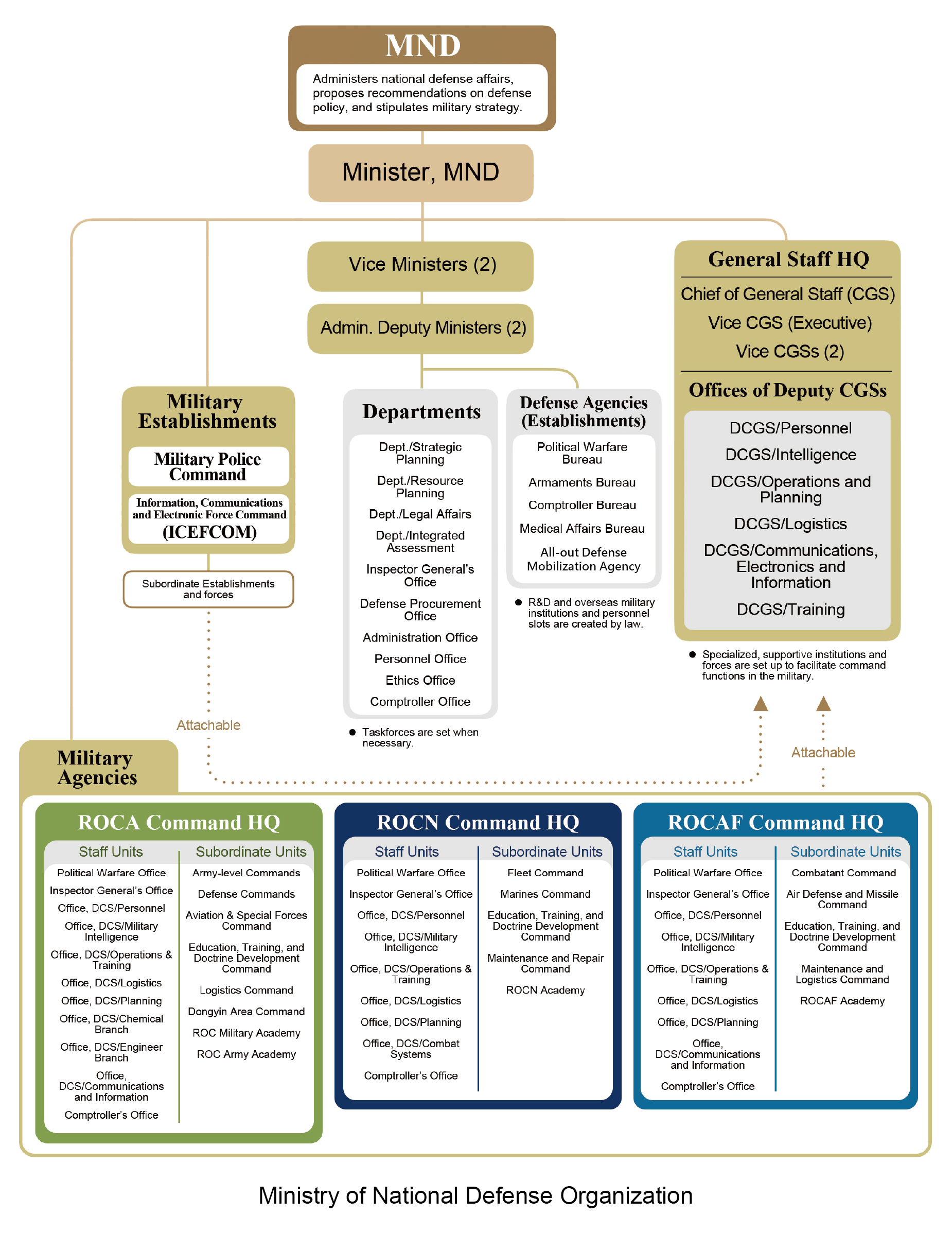中文

Ministry Of National Defense Organization: Departments, General Staff Headquarters, Defense Agencies, Military Agencies, Military Establishments.
Departments: Department of Strategic Planning; Department of Resource Planning; Department of Legal Affairs; Department of Integrated Assessment; Inspector General’s Office; Defense Procurement Office; Administration Office; Personnel Office; Ethics Office; Comptroller Office.
General Staff Headquarters: Office of the Deputy Chief of the General Staff for Personnel; Office of the Deputy Chief of the General Staff for Intelligence; Office of the Deputy Chief of the General Staff for Operations and Planning; Office of Deputy Chief of the General Staff for Logistics; Office of the Deputy Chief of the General Staff for Communication, Electronics and Information; Office of the Deputy Chief of the General Staff for Training.
Defense Agencies: Political Warfare Bureau; Armaments Bureau; Comptroller Bureau; Medical Affairs Bureau; All-out Defense Mobilization Agency.
Military Agencies: Army Headquarters; Navy Headquarters; Air Force Headquarters and Other military establishments.
Military Establishments: Military Police Command; Information, Communications and Electronic Force Command.
The ROC Constitution stipulates that the ROC national defense aims to defend the nation's security and safeguard world peace. Under this, the nation's defense concepts, military strategies, military buildup, and objectives are formulated to prevent conflict. The current international situation and changes to the possible threat to the ROC are also taken into consideration in the making of defense policies at the current stage. The basic objectives are "preventing war," "defending the homeland," and "countering terrorism and responding to contingencies." The higher strategic goal is "effective deterrence, resolute defense" with the establishment of a quality self-defensive force capable of counterattack.
China, though calling for reunification, has never renounced the use of force against Taiwan. It has not only deployed an increasing number of ballistic missiles aimed at Taiwan but also staged large-scale military exercises with an overt saber-rattling intent to destabilize Taiwan politically and economically. Moreover, its robust economic expansion in recent years has fueled its defense spending for greater military muscle. In order to maintain Cross-Strait stability and avoid a military imbalance in the Taiwan Strait, the ROC government is calling for the establishment of confidence-building measures (CBMs) and a code of conduct on the one hand, and, on the other hand, has been constructing basic defense forces and counterattack capability to safeguard the territory without engaging in an arms race with the other side.
Regarding the military buildup, the major emphases are on the development of the C4ISR system-command, control, communications, computer, intelligence, surveillance, and reconnaissance-missile defense, command of the air and command of the sea. On military procurement, the top three items on the procurement list- PAC-3 system, diesel-electric submarines, and fixed-wing ASW aircraft-are pending approval by the Legislative Yuan through a special budget appropriation in installments. These three are expected to tremendously elevate the armed forces' anti-blockade capability in active defense, expand deployment flexibility, and serve as a strategic deterrent.
The policy on military manpower will be oriented toward a combination of enlistment and conscription systems, featuring "regular forces from enlistment and reserve forces from conscription." For the military budget, the Ministry will follow the principles of "thriftiness and prudence" to rationally economize financial resources in line with the defense priority and operational readiness. As for defense materiel, the Ministry's principle is to integrate defense and industrial production by availing itself of the private sector's technological strength for defense uses to achieve the goal of a self-reliant national defense.
Above all the military building is to develop a consensus for an all-out participatory defense from every citizen. To allow the nation's military power to come into full play requires the mobilization of all civilians to support the "all-out defense." Only by consolidating national willpower-military and civilian alike-to protect the safety and security of the family, property and country can we guarantee national security, survival, and development.
Moreover, the Ministry has included disaster relief as a part of its operational missions, and reorganized its forces and equipment accordingly to create a disaster relief mechanism. With statutory authorization, the ROC Armed Forces can act on orders to carry out immediate rescue missions to save lives and property. This can achieve a sense of oneness between the military and the civilian population.
In recent years, the MND, considering domestic and global situations, has endeavored to reorganization in line with necessary adjustments in national security strategy, and based upon public opinion to become more professional. Also, taking into consideration the enemy's threat, operational requirements, resource limitations, and the promotion of the efficacy of joint operations, the Ministry has strictly carried out a revolution in military affairs (RMA). The ultimate goal is to establish an accountable, professional, and highly efficient military unit that can accomplish its mission and the meet the people's expectations.